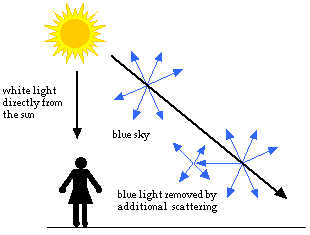The earth’s atmosphere is a strange and miraculous layer which is the main reason for many of the beautiful landscapes we can see from earth. We won’t be exaggerating if we say that the sky is probably one of the most beautiful things you can observe from earth without any special equipment. In most cases the sky looks blue and this is because the atmosphere scatters the incoming sunlight. However, the sky itself isn’t blue – it just looks that way. The sky’s color and brightness varies everywhere and you can’t expect from citizens of two distant towns to see the same sky color.

Sunlight contains all the colors of the rainbow – red, green, blue, yellow, violet and indigo. The atmosphere disperses these colors and gives the sky a unique look at different locations. However, atmosphere scatters each color in a different way – this is because sunlight reaches the Earth in the form of wave and each color consists of waves with a varying frequency. Violet is the color with the highest frequency and red has the lowest frequency while the frequencies of all other colors fall between.
The first person to learn more about light scattering was the English scientist Lord Rayleigh. His studies showed that small and large particles scatter light differently. For example small particles like air molecules scatter the high frequency colors violet and blue better than red. Light scattered by air molecules contains more blue and violet, but the human eyes are used to seeing blue better than violet. This is why most of the time we see the sky blue. The sky seems red at sunrise and sunset because of Rayleigh scattering. At this time of the day, the sun is higher and the sunlight passes through more air molecules before reaching our eyes. The scattering removes the violet and blue, leaving the low frequency red which gives the sky a red or orange color.
Big droplets of water which collect dust in order to form clouds and fog are too big to scatter light and they scatter all colors equally. In this case the formed clouds look white. Smaller droplets on the other hand absorb the light and emit it in all directions and, because of this we see the light coming from everywhere. This leads us to the conclusion that scattered light isn’t just blue – it contains other colors as well, therefore the sky isn’t blue – it is sky blue.
In Short:
The factors which determine the sky’s color are sunlight and the range of particles that are found in the Earth’s atmosphere. The Sun may look white when observed from Earth, but actually, its surface consists of the entire color spectrum. The sky’s color changes depending on the angle at which the sunlight hits Earth and the type and amount of solid and gaseous particles found in the Earth’s atmosphere.


